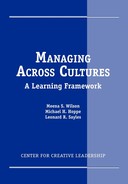0%
21Chapters
0-1Hours read
0kTotal Words
Table of Contents
- Cover
- Title Page
- Copyright
- Dedication
- Table of Contents
- Preface
- Acknowledgments
- Introduction
- Source of Identity: Individual-Collective
- Goals and Means of Achievement: Tough-Tender
- Orientation to Authority: Equal-Unequal
- Response to Ambiguity: Dynamic-Stable
- Means of Knowledge Acquisition: Active-Reflective
- Perspective on Time: Scarce-Plentiful
- Outlook on Life: Doing-Being
- Using the Framework
- Conclusion
- References
- Appendix: Models of Cultural Difference
